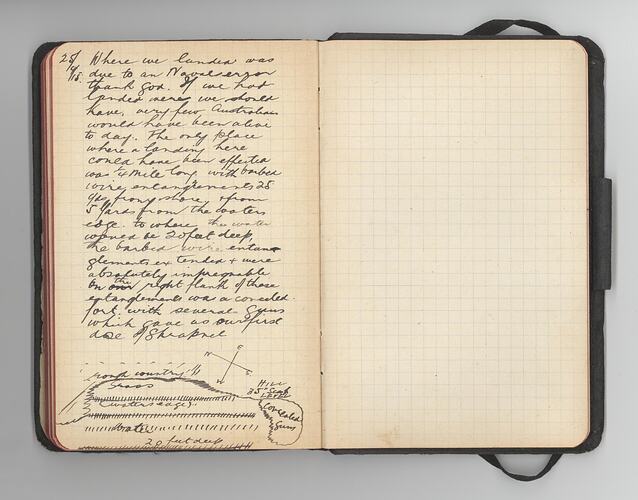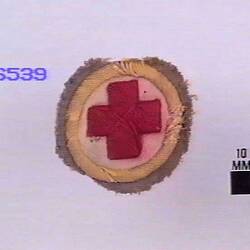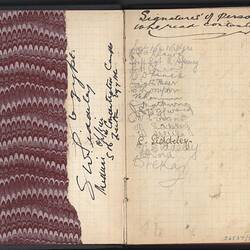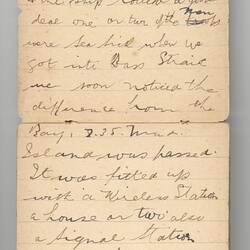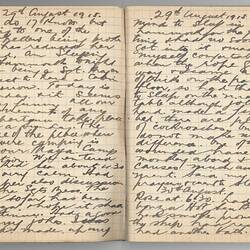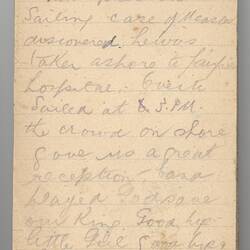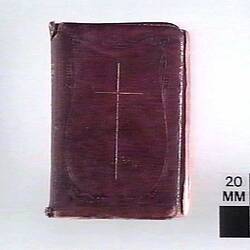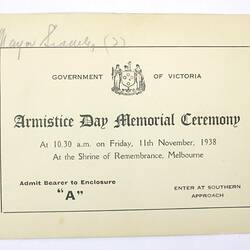Born in 1895, in St. Kilda, as one of five children to Fred Saxon Siddeley and Lillian Evangeline Siddeley (nee McQueen), Corporal William McQueen Saxon 'S.W.' Siddeley would become a member of the Australian Army Medical Corps, 1st AIF. Prior to enlistment, Siddeley worked as a chemist and private secretary at Henry Francis and Company, Chemists, 282 Bourke Street, Melbourne, which gave him considerable knowledge of pharmaceuticals, prescription writing, Latin and Pitman-style shorthand. Although there is no record of Siddeley attending medical school through Melbourne University (the only medical school in Victoria at this time) the skills he developed at Henry Francis & Co. proved very useful as a medical officer during World War I, with many extant examples in his war diaries. For twelve months prior to enlisting, Siddeley assisted the AIF Medical Officers at training camps in Seymour, Victoria and Queenscliff, Victoria.
When he enlisted as a 19-year-old at Broadmeadows on 18 August 1914, Siddeley became a member of the Australian Army Medical Corps, 1st AIF, attached to the 5th Battalion, Regimental Number 1053. He embarked for service abroad on 21 October 1914 as a Canteen (or Staff) Sergeant on the HMT Afric. He later took part in the first landing at Gallipoli on 24 April 1915. On the Gallipoli Peninsula he worked as a Medical Officer in horrendous conditions, while recording his daily life in a set of three diaries. His character and conduct while serving in the AIF was described as 'good' with no history of misconduct or venereal disease.
On 18 May 1915, while in Cape Helles, Gallipoli, Siddeley was struck by shrapnel while under attack on the beach and sustained a serious concussion. Although this is not mentioned explicitly in his own diaries, there is a three month gap in his diary entries from 11 May 1915 to 27 August 1915, his service records report him to have 'defective eyesight' (blindness in his right eye due to concussion, and shell shock.) His Casualty Form and diary indicate that he left Luna Park Hospital, Mena Camp, Cairo, for Australia on the 'Euripides' on 29 August 1915, arriving 1 October. After time in hospital in Australia, including six months in an Army Rehabilitation hospital for shell shock, Siddeley was then granted an extended two-month furlough, which he took with relatives in the Blue Mountains, N.S.W. He was discharged from the 3rd Medical Unit on 15 May 1916, being 'medically unfit' 'not due to misconduct'.
On 1 November 1916, he was re-assigned to begin duties as a Canteen Sergeant on the troopship HMT 'Afric'. He went overseas again, but only briefly. On 12 February 1917 the 'Afric' was torpedoed and sunk in the English Channel. Five died in the explosion, 17 drowned and 145 survived. This tragedy marked the end of Siddeley's war-time service, and possibly re-ignited his neurasthenia and shell-shock. However, he was not admitted to hospital in England due to over-crowding. He left Plymouth for Australia on the 'Beltana' on 17 March 1917, his 'services no longer required', arriving in Australia in mid-May 1917.
Immediately after the War, Siddeley worked on a Sugar Plantation in Papua New Guinea and the Australian Naval Office in Melbourne. From 1926 Siddeley (ironically) became an eyesight specialist, working from the Finks Buildings, 6A Elizabeth Street, Melbourne. However, he was only able to work part-time for much of the rest of his life, and in his personal statements feels that his war service was the cause of this, as he had been 'completely healthy' upon enlistment.
Through the next decades, Siddeley's health continued to be marred by his wartime experience, and injuries. He was granted a War Pension of 90% of the full disability rate in the years following the war; however the rate fluctuated up and down over the course of his life. As a result Siddeley and his wife Ethel Constance fought and appealed through the rest of their years to stabilise and maintain his benefits.
The family reported that he had one short episode when he was admitted to the 'neurotic ward' at the Heidelberg Repatriation Hospital. The war clearly had a strong effect upon 'Sax' Siddeley. His Department of Veterans' Affairs Repatriation and Hospital files reveal the full extent of his many hospitalisations through life, including stays in a Sanatorium in 1929-1930, and admissions to Heidelberg Repatriation Hospital for 'Acute Neurotic Conditions' and insomnia as late as 1963.
His symptoms were variously noted throughout his dealings with the Department of Veterans' Affairs as 'Neurasthenia', 'Insomnia', 'Vertigo', etc. However he never really received compensation owing to shell shock or post-traumatic stress disorder, as it may have been diagnosed today.
He died on 24 April 1971, survived by his wife Ethel until her passing in 1990. Ethel donated his diaries and other associated objects to the Victorian Branch of the R.S.L. They were subsequently transferred to Museum Victoria in 1984. There is no record of the Siddeley's marriage to Ethel in the Victorian Register of Births, Deaths and Marriages, and they do not appear to have had any children. They are also listed as without dependants in Siddeley's Department of Veterans' Affairs files. Both are now buried in Springvale Cemetery, Victoria.
References
Australian Imperial Force, Base Records Office, 1914 - 1920. SIDDELEY William Mcqueen Saxon : Service Number - 1053 : Place of Birth - Melbourne VIC : Place of Enlistment - Melbourne VIC : Next of Kin - (Mother) SIDDELEY Lilian. [archives] First Australian Imperial Force Personnel Dossiers, 1914-1920. B2455, SIDDELEY WILLIAM MCQUEEN SAXON. Canberra: National Archives of Australia
Deputy Commissioner for Repatriation, 1955-1971. Siddeley, William McQueen Saxon 1053. [archives] Personal case files, World War I. B73, M232 PART 1. Melbourne: National Archives of Australia.
Deputy Commissioner of Invalid and Old-Age Pensions, Maternity Allowances, and War Pensions, Deputy Commissioner for Repatriation, Department of Veterans' Affairs, 1914-1984. Siddeley, William McQueen Saxon 1053 [archives] Personal case files, World War I. B73, M232 PART 2. Melbourne: National Archives of Australia.
More Information
-
Keywords
World War I, 1914-1918, Military History, Australian Military Forces, Military Forces, Medicine and health
-
Localities
-
Authors
-
Article types
